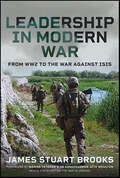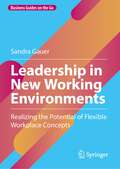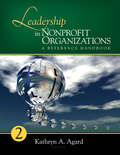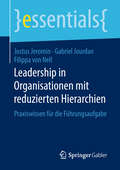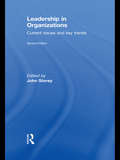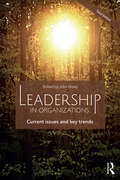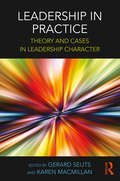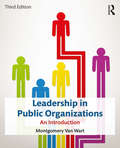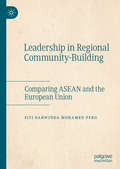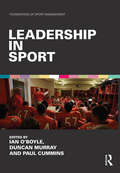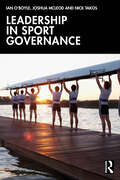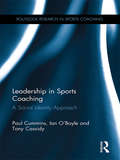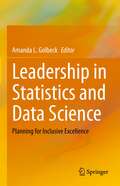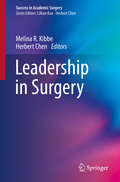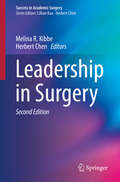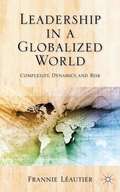- Table View
- List View
Leadership in Law: Amy Schulman at DLA Piper
by Boris Groysberg Victoria W. Winston Shirley M. SpenceWhat does it take to build a successful career over time? Describes Amy Schulman's career progression and role as a star senior litigator and top executive at one of the world's largest law firms. It focuses on different stages in her career and what she did to be successful at each stage. The demands on her time--client development, casework, firm leadership responsibilities, mentoring her people, managing her team, spending time with her family--were changing over time. After being chosen to sit on the firm's Global Board as well as its Executive and Policy Committees, Amy Schulman feels that there are things that are being left undone. She must decide how to allocate her time.
Leadership in Law: Amy Schulman at DLA Piper
by Boris Groysberg Victoria W. Winston Shirley M. SpenceWhat does it take to build a successful career over time? Describes Amy Schulman's career progression and role as a star senior litigator and top executive at one of the world's largest law firms. It focuses on different stages in her career and what she did to be successful at each stage. The demands on her time--client development, casework, firm leadership responsibilities, mentoring her people, managing her team, spending time with her family--were changing over time. After being chosen to sit on the firm's Global Board as well as its Executive and Policy Committees, Amy Schulman feels that there are things that are being left undone. She must decide how to allocate her time.
Leadership in Leisure Services: Making a Difference (Third Edition)
by Debra J. JordanLeadership is a process and an experience that impacts all of us in our roles as leaders and as followers. This text presents leadership as a personal journey that takes conscious effort to undertake and develop. Leadership is one of the keystones of successful parks, recreation and leisure services agencies, organizations and programs. How we deal with people,how we interact with fellow staff supervisors, participants, and the general public all make an incredible statement about who we are and what our profession is about. This book is designed to help students of leadership begin, or renew, their personal journey toward leadership.
Leadership in Modern War: From WW2 to the War Against ISIS
by James Stuart BrooksHow would you react under fire? Fight or flight? What if you were in charge of a squad of men, with their lives in your hands? The next decision you make could be fatal for you and your comrades or could be devastating to your enemy. The wrong decision could haunt you for the rest of your career and beyond. The decisions taken by commanders in the field are analyzed in a detached manner by historians. But what, for example, was the thought process of a reconnaissance tank officer operating far ahead of any supporting troops in the Second World War, or a machine-gunner trying to differentiate friend from foe in the Gulf War? How might a British infantry officer in the Iraq War deal with the situations he faced in combat, or a platoon commander in the War Against ISIS, where the enemy had no fear of dying and even embraced it? How do you come to terms with the consequences of your decisions, the right ones as well as the tragically wrong ones? James Brooks presents defining moments such as these to put you in the shoes of the decision-maker. You can decide when to cross a bridge in Taliban territory, whether to land a helicopter under fire to rescue Marines in danger, and how to lead a command center targeting ISIS through air strikes. These decisions, compared with what the veterans did themselves, teach more about humanity than they do about the tactics of war and serve as lessons for the decisions we face in everyday life. In a career that traced the rise and fall of ISIS from 2014 to 2021, James served in the US Marine Corps as a scout sniper platoon commander, intelligence officer, and counter-propaganda mission lead. After two deployments to the Middle East and a year-and-a-half fighting ISIS propaganda online, James returned to his hometown to teach a subject called “Perspectives in Modern War” to high school seniors. Building from the stories of his own service, as well as those of the men and women he fought alongside, in Leadership in Modern War James captures these lessons and explores just what it is like to be on the front line facing your foe. Warfare has changed in the twenty-first century, but the enduring lessons of conflict remain the same. It is brutal and unforgiving – but it is also character-defining.
Leadership in New Working Environments: Realizing the Potential of Flexible Workplace Concepts (Business Guides on the Go)
by Sandra GauerThis book discusses the challenges that modern and flexible workplace concepts pose for managers. In particular, it addresses the uncertainties and stress factors that employees face when working in multi-space environments and how they become attached to their workplace. Drawing on a hybrid methodological approach that combines a literature review with practical lessons learned as a workplace change consultant, it offers managers concrete advice on how to lead in multi-space environments. This book aims to reduce the uncertainties and stressors caused by new work environments, and ideally to transform them into growth opportunities for the entire company. Providing concrete solutions, it represents a valuable asset for managers, HR professionals, and workplace initiative leaders alike.
Leadership in Nonprofit Organizations: A Reference Handbook
by Kathryn A. AgardLeaders of nonprofit organizations deliver programs and services vital to the quality of life in the United States. All the activities of our religious communities; the vast majority of the arts and culture, human services, and community development pursuits; as well as education and environmental advocacies take root and deliver their services within the nonprofit sector.Welcome to the world of leadership in nonprofit organizations. This sector offers an opportunity to serve as well as to lead. Leadership in Nonprofit Organizations: A Reference Handbook engages voices on issues and leadership topics important to those seeking to understand more about this dynamic sector of society. A major focus of this two-volume reference work is on the specific roles and skills required of the nonprofit leader in voluntary organizations.Key FeaturesPresents contributions from a wide range of authors who reflect the variety, vibrancy, and creativity of the sector itselfProvides an overview of the history of nonprofit organizations in our countryDescribes a robust and diverse assortment of organizations and opportunities for leadershipExplores the nature of leadership and its complexity as exemplified in the nonprofit sectorIncludes topics such as personalities of nonprofit leaders; vision and starting a nonprofit organization; nonprofit law, statutes, taxation, and regulations; strategic management; financial management; collaboration; public relations for promoting a nonprofit organization; and human resource policies and proceduresNonprofit organizations are a large, independent, diverse, and dynamic part of our society. This landmark Handbook tackles issues relevant to leadership in the nonprofit realm, making it a welcome addition to any academic or public library.
Leadership in Organisationen mit reduzierten Hierarchien: Praxiswissen für die Führungsaufgabe (essentials)
by Justus Jeromin Gabriel Jourdan Filippa Von NellIn diesem essential stellen die Autoren zun#65533;chst drei theoretische Konzepte zu reduzierten Hierarchien und deren individuelle Merkmale vor. Anschlie#65533;end thematisieren sie das Management-Framework Scrum. Dabei beschreiben die Autoren anschaulich die notwendige Umgebung f#65533;r selbstorganisierende und eigenverantwortliche Fertigstellung von Produktinkrementen. In der anschlie#65533;enden Diskussion f#65533;hren sie die allgemeine Theorie und ein spezielles Beispiel zusammen. Abschlie#65533;end fassen die Autoren die Inhalte der vorausgegangenen theoretischen Kapitel zusammen und formulieren vier wichtige Key-Learnings oder Take Away Messages. Diese Take Away Messages sind eine hilfreiche Orientierung in der Praxis f#65533;r Leader und Team-Mitglieder von Organisationen mit reduzierten Hierarchien.
Leadership in Organizations
by Gary YuklThe most comprehensive survey of major theories and research on leadership and managerial effectiveness in organizations with practical suggestions for improving skills. Balancing theory and research with applications, the book addresses controversies and differing viewpoints about leadership effectiveness with a focus on the question of what makes a person an effective leader. Covering charismatic and transformational leadership as well as influence processes, it asks readers to identify effective and ineffective behavior by managers and to suggest ways to handle the situation. The fourth edition of "Leadership in Organizations" has been revised to reflect the progress that has been made in understanding leadership since the first edition. It provides more guidelines and recommendations for improving effectiveness without prescribing how a manager must behave. And, it covers "hot" topics, such as charismatic and transformational leadership, influence processes, leading teams, and leading change. An essential reference on management and leadership for every professional manager.
Leadership in Organizations
by John StoreyOf the many books written about leadership, few move beyond conventional accounts of theory, or truly scrutinise the leadership agenda. However, this exciting book sets a new agenda for the interpretation of leadership and development. Including contributions from some of the most distinctive leaders in the field, it considers the newest themes to come out of the leadership debate. Topics covered include: * leadership and integrity* learning leadership* career individualization* leadership development in the public sector. One of the first books to systematically link leadership and management, this distinctive and challenging text examines leadership in the context of career development. It critically assesses the more conventional training and development available to managers, and in doing so equips readers with the analytical perspectives and tools needed to understand the significance of leadership in contemporary organizations.
Leadership in Organizations: Current Issues and Key Trends
by John StoreyLeadership has proved a tricky beast to pin down and the subject has been approached from a variety of perspectives over the years. The beauty of this textbook lies in its role as an illustrative guide though the wilds of an elusive discipline. This second edition of Leadership in Organizations: Current Issues and Key Trends offers a balanced combination of theory and practice to provide an up-to-date account of this multi-faceted topic. Looking at the international and comparative aspects of leadership, Storey also discusses new modes of leadership that will be required to steer organizations to success in a recessive environment. Topics include: Changing theories of leadership Strategy and leadership Ethics and leadership Leadership development in public sector organizations Followership and distributed leadership Leadership development in multi-national firms With improved pedagogical features, this new edition is the ideal text for students of leadership studies, as well as practitioners looking to enhance their leadership skills.
Leadership in Organizations: Current Issues and Key Trends
by John StoreyThis third edition of Leadership in Organizations: Current Issues and Key Trends builds on the success of the previous versions, with new and updated chapters providing fresh and lively insights into a subject that can often be tricky to pin down. Leadership in Organizations carefully balances theory and practice, including critical perspectives, to examine fundamental questions about the meaning of leadership, its use and its development. Readers will benefit from the text’s rich use of cases and examples of real-life tensions, challenges and successful outcomes of leadership practice. The book also sets itself apart through its distinctive focus on leadership within the wider contexts of politics, economics and public policy, as well as organizational behaviour and management. New elements for this edition include: The moral pitfalls of leadership Leadership roles under crisis conditions Fresh analysis of the impact of leadership on performance outcomes This is the ideal text for advanced students of leadership studies, as well as practitioners looking to deepen their understanding of the leadership process and to enhance their leadership skills.
Leadership in Practice: Theory and Cases in Leadership Character
by Gerard Seijts Karen MacMillanRecent financial crises and other high-profile mismanagement cases have brought a spotlight to the quality of leader character in the business sector. Leadership in Practice is the first book to provide an authoritative collection of cases to engage students interested in the importance of the character of business leaders. The authors have compiled a collection of cutting-edge cases and readings, situating them within a theoretical landscape, so students are familiarized with the concepts as they move through the text. The cases cover a wide range of successful businesses—from the NFL to Apple—and include notable controversies, such as those surrounding Enron and Volkswagen. Alongside exclusive interviews and insights into the value of leadership character at individual, team, organizational and societal levels, the book includes learning objectives and discussion questions to facilitate lively debate and interaction in the classroom. This volume will be a valuable supplement for students and instructors in any leadership class as well as researchers and practitioners interested in exploring case studies that illuminate the nature of leadership in a business setting.
Leadership in Public Organizations: An Introduction
by Montgomery Van WartLeadership in Public Organizations is a concise yet comprehensive treatment of public sector leadership for upper division and graduate students. In addition to a full, up-to-date review of leadership theories in the field, it covers the major competency clusters in detail, and provides both the research on each competency and practical guidelines for improvement. These competencies are graphically portrayed in a Leadership Action cycle that aids students in visually connecting theory and practice. Important features of the text include discussion questions and scenarios at the end of each chapter, numerous exhibits, and an easily reproducible leadership assessment instrument. Although designed for course use in a Public Administration program, Leadership in Public Organizations can also serve as a guidebook for professionals seeking insight into the role of successful leadership behavior in public sector management.
Leadership in Public and Nonprofit Organizations: An Introduction
by Montgomery Van Wart Pamela S. MedinaLeadership in Public and Nonprofit Organizations, Fourth Edition provides a compact but complete analysis of leadership for students and practitioners who work in public and nonprofit organizations. Offering a comprehensive review of leadership theories in the field, from the classic to the cutting-edge, and how they relate specifically to the public sector and nonprofit contexts, this textbook covers the major competency clusters in detail, supported by research findings as well as practical guidelines for improvement. These competencies are portrayed in a leadership action cycle that aids readers in visually connecting theory and practice. This thoroughly revised new edition also offers: Questions for discussion and analysis, hypothetical scenarios for each chapter, as well as an easily reproducible leadership assessment instrument students may use to apply the theories they’ve learned Expanded coverage of nonprofit leadership integrated throughout the chapters, including in-depth discussions about managing volunteers, fundraising ethics, the nonprofit board, advocacy, diversity and philanthropy, emotional labor, and mission-based leadership An all-new chapter section on virtual leadership approaches, designed to help current and future managers cope with the unique opportunities and challenges present by remote work Leadership in Public and Nonprofit Organizations is not only an essential core text designed specifically with upper-level and graduate public administration and nonprofit management courses on leadership in mind, but it has also proven an indispensable guidebook for professionals seeking insight into the role of successful leadership behavior in the public and nonprofit sectors. It can further be used as supplementary reading in introductory courses examining management competencies, in leadership classes to provide practical self-help and improvement models, and in organizational theory classes that wish to balance organizational perspectives with individual development.
Leadership in Regional Community-Building: Comparing ASEAN and the European Union
by Siti Darwinda Mohamed PeroThis book examines the role of political leadership as a driver in the process of regional community-building in the Association of Southeast Asian Nations (ASEAN) and the European Union (EU). It considers under which conditions political leadership constitutes a driver of regional community-building and reconceptualises the very idea of political leadership in order to examine its role in a regional context. The book concludes that a comprehensive approach that incorporates political will, the capacity of individual leaders, state capacity, legitimacy, and summitry yields a deeper understanding of political leadership in regional bodies.
Leadership in Sport (Foundations of Sport Management)
by Ian O'Boyle Duncan Murray Paul CumminsEffective leadership is essential in any sports organisation, both in the boardroom and on the training pitch. Leadership in Sport is the first textbook to examine sports leadership in the round, across both management and coaching environments. It includes a dedicated section to underpinning core leadership theories, and employs a number of case studies throughout to show how best practice is applied in real world settings. Drawing on expertise from some of the leading academics and practitioners throughout the world, and from both disciplines, the book covers various leadership issues including: facilitative leadership strategic leadership leading effective change diversity in leadership communication and empathy motivation and performance. Key conceptual questions—the nature of leadership, its role in sport, styles of leadership, what constitutes ineffective leadership—and other contemporary issues are also explored to give students and practitioners the most complete and clear picture of contemporary leadership in sport. With useful features in every chapter, such as key terms and review questions, this is an essential text for sport management or coaching degree courses.
Leadership in Sport Governance
by Ian O'Boyle Joshua McLeod Nick TakosThis is a concise introduction to leadership and governance theory and how they are applied in sport. Presenting a series of case studies from around the world, the book offers a detailed guide to best practice in the leadership of sport boards and organisations. Drawing on cutting-edge research, the book sets out the core concepts and principles of good leadership and good governance, explaining their importance in an era in which sport organisations have become increasingly bound by legal frameworks and subject to greater calls for accountability from wider society. The book analyses the key issues related to leadership in sport governance, including leadership styles with a focus on authentic leadership; intra-group dynamics; managing conflict and trust; leading in multi-layered networks; strategic leadership; and diversity, equity, and inclusion (DEI); and it considers the differing requirements of sport leadership in different geographical locations, under varying challenges and pressures. Full of illuminating cases, data and examples, this is an invaluable reading for any course in sport business and management and a useful primer for any sport business professional looking to improve their professional knowledge.
Leadership in Sports Coaching: A Social Identity Approach (Routledge Research in Sports Coaching)
by Ian O'Boyle Tony Cassidy Paul CumminsThe professionalisation of sports coaching has demanded higher standards of leadership in order to improve performance and effectiveness. This book focuses on leadership in sports coaching, exploring key concepts and principles underpinned by a presentation of new empirical research. Placing social identity theory at its centre – a theory not previously applied to sports coaching – this book provides students and researchers with a powerful tool for understanding the complex social dynamic that is the coaching process. Its chapters cover all the central aspects of sports coaching, including leadership style, measuring effectiveness, motivation, confidence and team self-esteem. Chapters explore different coaching environments to investigate the extent to which social identity impacts on coaching and leadership. A ground-breaking contribution to this field of research, this book demonstrates the significance of social identity theory in sport for athletes, coaches and leaders. Leadership in Sports Coaching: A social identity approach is an illuminating read for any student or researcher with an interest in coaching theory, coaching practice, sport psychology, sport leadership or sport management.
Leadership in Statistics and Data Science: Planning for Inclusive Excellence
by Amanda L. GolbeckThis edited collection brings together voices of the strongest thought leaders on diversity, equity and inclusion in the field of statistics and data science, with the goal of encouraging and steering the profession into the regular practice of inclusive and humanistic leadership. It provides futuristic ideas for promoting opportunities for equitable leadership, as well as tested approaches that have already been found to make a difference. It speaks to the challenges and opportunities of leading successful research collaborations and making strong connections within research teams. Curated with a vision that leadership takes a myriad of forms, and that diversity has many dimensions, this volume examines the nuances of leadership within a workplace environment and promotes storytelling and other competencies as critical elements of effective leadership. It makes the case for inclusive and humanistic leadership in statistics and data science, where there often remains a dearth of women and members of certain racial communities among the employees. Titled and non-titled leaders will benefit from the planning, evaluation, and structural tools offered within to contribute inclusive excellence in workplace climate, environment, and culture.
Leadership in Surgery
by Herbert Chen Melina R. KibbeHow does one become a successful leader? This book teaches the theories and concepts behind leadership and explains the skills and traits needed to become a good leader. Teaching surgical faculty and trainees (i. e. , residents and fellows) how to successfully lead will create more effective surgeon leaders. The skills and theories reviewed in this Volume are highly useful for numerous leadership situations, ranging from heading a committee, leading a research laboratory, directing a clinical effort, leading a Division, leading a Department, among others. By gathering these skills and theories into one comprehensive, portable book, more readers will have access to them.
Leadership in Surgery: Leadership In Surgery (Success in Academic Surgery)
by Herbert Chen Melina R. KibbeThis updated volume provides a guide to the theories and concepts of leadership in surgery. New chapters on team motivation, understanding different healthcare systems, and leadership negotiation are included. Practical management skills are also covered, including how to manage difficult personalities, change management, and conflict resolution techniques. Leadership in Surgery examines the skills and characteristics needed to be a good leader and aims to improve surgical leadership. The book is relevant to both trainees and practicing surgeons.
Leadership in War and Peace: Masculine and Feminine
by Joan Johnson-FreeseThis book offers a gendered perspective on leadership in war and peace, considering leadership in its complexity and presenting a practical examination of both leadership successes and failures.The work challenges readers to think through and discuss specific aspects of leadership, including how and why leadership diversity matters and the ethical challenges presented by the revolving door of the military–industrial complex. Further, leaders responsible for decisions involving war and peace must be able to understand, appreciate, and communicate effectively with everyone they work with and have a repertoire of leadership styles to use depending on context. The book represents an excellent tool for developing such skills, as it uniquely considers leadership through both male and female lenses, along with the experiences and perspectives of multiple military, government, and industry leaders interviewed by the author, making it both relatable and informative.This book will be of much interest to students of gender studies, leadership studies, defense studies, and military studies in general, as well as military and security practitioners.
Leadership in a Challenging World
by Barbara ShipkaLeadership in a Challenging World is about a journey to wholeness. The whole self is sacred and required in order to lead well in the complex world of today and tomorrow. Divided into 3 parts, the book begins with the metaphor of the forest for the world, with both its demanding challenges and its magnificent possibilities. Part 2 uses the metaphor of walking on a path to suggest eight subjective human powers that are essential to leading in business today and tomorrow. Finally. part 3 describes an ancient basis for the powers and shows how they can serve to bring balance to each other that results in human wholeness.
Leadership in a Diverse and Multicultural Environment: Developing Awareness, Knowledge, and Skills
by Paul B. Pedersen Dr Mary L. ConnerleyLeadership in a Diverse and Multicultural Environment provides leaders with the tools necessary to effectively interact with all individuals. Although much of the research related to multiculturalism has focused on expatriates and international assignments, the book also focuses on leaders in domestic organizations, as they can benefit from developing their own multicultural awareness, knowledge, and skills. Effective leaders can shape the culture of their organization to be accepting of individuals from all races, ethnicities, religions, and genders with a minimum of misunderstandings.
Leadership in a Globalized World: Complexity, Dynamics, and Risks
by Frannie LéautierThis book investigates key issues facing leaders in increasingly complex decision-making environments as a result of globalization. It presents a synthesis and interpretation of academic research in multiple disciplines and integrates it into a practical approach that is readily useable by leaders in government, corporations, and civil society.

